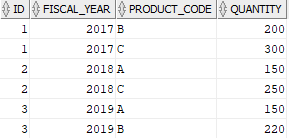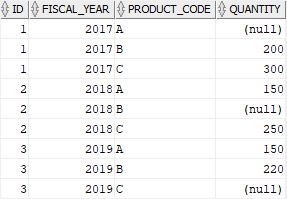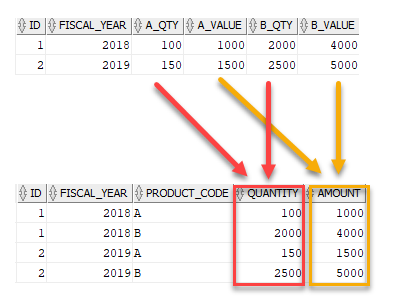Summary: in this tutorial, you will learn how to use the Oracle UNPIVOT clause to transpose columns to rows.
Introduction to Oracle UNPIVOT clause #
The Oracle UNPIVOT clause allows you to transpose columns to rows. The UNPIVOT clause is opposite to the PIVOT clause except that it does not de-aggregate data during the transposing process.

The following illustrates the syntax of the Oracle UNPIVOT clause:
SELECT
select_list
FROM table_name
UNPIVOT [INCLUDE | EXCLUDE NULLS](
unpivot_clause
unpivot_for_clause
unpivot_in_clause
);
Code language: SQL (Structured Query Language) (sql)In this syntax:
- The
unpivot_clauseallows you to specify a name for a column that represents the unpivoted measure values. - The
unpivot_for_clauseallows you to specify the name for each column that will hold the measure’s values. - The
unpivot_in_clausecontains the pivoted columns that will be unpivoted.
The INCLUDE | EXCLUDE NULLS clause allows you to include or exclude null-valued rows.
- The
INCLUDE NULLSclause instructs Oracle to include null-valued rows. - The
EXCLUDE NULLSclause, on the other hand, eliminates null-valued rows from the returned result set.
By default, the unpivot operation excludes null-valued rows.
Let’s take some examples of using the Oracle UNPIVOT clause to get a better understanding.
Setting up a sample table #
First, create a new table called sale_stats for demonstration:
CREATE TABLE sale_stats(
id INT PRIMARY KEY,
fiscal_year INT,
product_a INT,
product_b INT,
product_c INT
);
Code language: SQL (Structured Query Language) (sql)Second, insert some rows into the sale_stats table:
INSERT INTO sale_stats(id, fiscal_year, product_a, product_b, product_c)
VALUES(1,2017, NULL, 200, 300);
INSERT INTO sale_stats(id, fiscal_year, product_a, product_b, product_c)
VALUES(2,2018, 150, NULL, 250);
INSERT INTO sale_stats(id, fiscal_year, product_a, product_b, product_c)
VALUES(3,2019, 150, 220, NULL);
Code language: SQL (Structured Query Language) (sql)Third, query data from the sale_stats table:
SELECT * FROM sale_stats;
Code language: SQL (Structured Query Language) (sql)Here is the output:

Oracle UNPIVOT examples #
This statement uses the UNPIVOT clause to rotate columns product_a, product_b, and product_c into rows:
SELECT * FROM sale_stats
UNPIVOT(
quantity -- unpivot_clause
FOR product_code -- unpivot_for_clause
IN ( -- unpivot_in_clause
product_a AS 'A',
product_b AS 'B',
product_c AS 'C'
)
);
Code language: SQL (Structured Query Language) (sql)In this example:
The unpivot_clause is quantity which is a column that represents the unpivoted values from the product_a, product_b, and product_c columns.
The unpivot_for_clause is FOR product_code, which is the column that will hold the measure’s values.
The unpivot_in_clause clause is:
IN ( -- unpivot_in_clause
product_a AS 'A',
product_b AS 'B',
product_c AS 'C'
)
Code language: SQL (Structured Query Language) (sql)which instructs Oracle to unpivot values in the product_a, product_b, and product_c columns.
The following picture shows the output:

By default, the UNPIVOT operation excludes null-valued rows, therefore, you don’t see any NULL in the output.
The following example uses the UNPIVOT clause to transpose values in the columns product_a, product_b, and product_c to rows, but including null-valued rows:
SELECT * FROM sale_stats
UNPIVOT INCLUDE NULLS(
quantity
FOR product_code
IN (
product_a AS 'A',
product_b AS 'B',
product_c AS 'C'
)
);
Code language: SQL (Structured Query Language) (sql)Here is the output:

Oracle unpivot multiple columns #
Let’s see an example of unpivoting multiple columns.
First, drop and recreate the sale_stats table:
DROP TABLE sale_stats;
CREATE TABLE sale_stats(
id INT PRIMARY KEY,
fiscal_year INT,
a_qty INT,
a_value DEC(19,2),
b_qty INT,
b_value DEC(19,2)
);
Code language: SQL (Structured Query Language) (sql)Second, insert rows into the sale_stats table:
INSERT INTO sale_stats(id, fiscal_year, a_qty, a_value, b_qty, b_value)
VALUES(1, 2018, 100, 1000, 2000, 4000);
INSERT INTO sale_stats(id, fiscal_year, a_qty, a_value, b_qty, b_value)
VALUES(2, 2019, 150, 1500, 2500, 5000);
Code language: SQL (Structured Query Language) (sql)Third, query data from the sale_stats table:
SELECT * FROM sale_stats;
Code language: SQL (Structured Query Language) (sql)
Finally, use the UNPIVOT clause to transpose the values in the column a_qty, a_value, b_qty, and b_value into rows:
SELECT * FROM sale_stats
UNPIVOT (
(quantity, amount)
FOR product_code
IN (
(a_qty, a_value) AS 'A',
(b_qty, b_value) AS 'B'
)
);
Code language: SQL (Structured Query Language) (sql)Here is the result set:

This picture illustrates the transposing process:

Summary #
- Use the Oracle
UNPIVOTclause to transpose columns to rows.